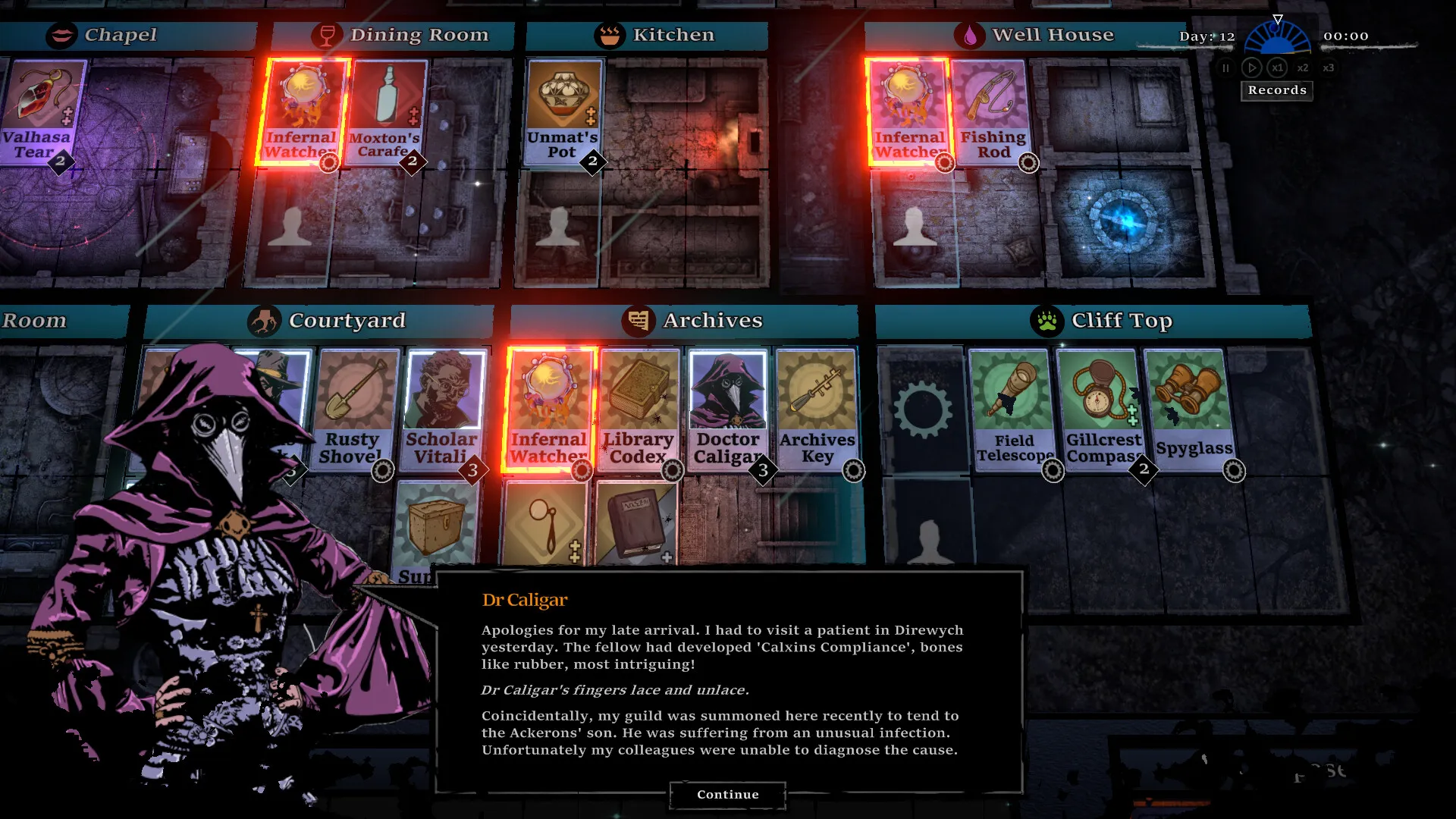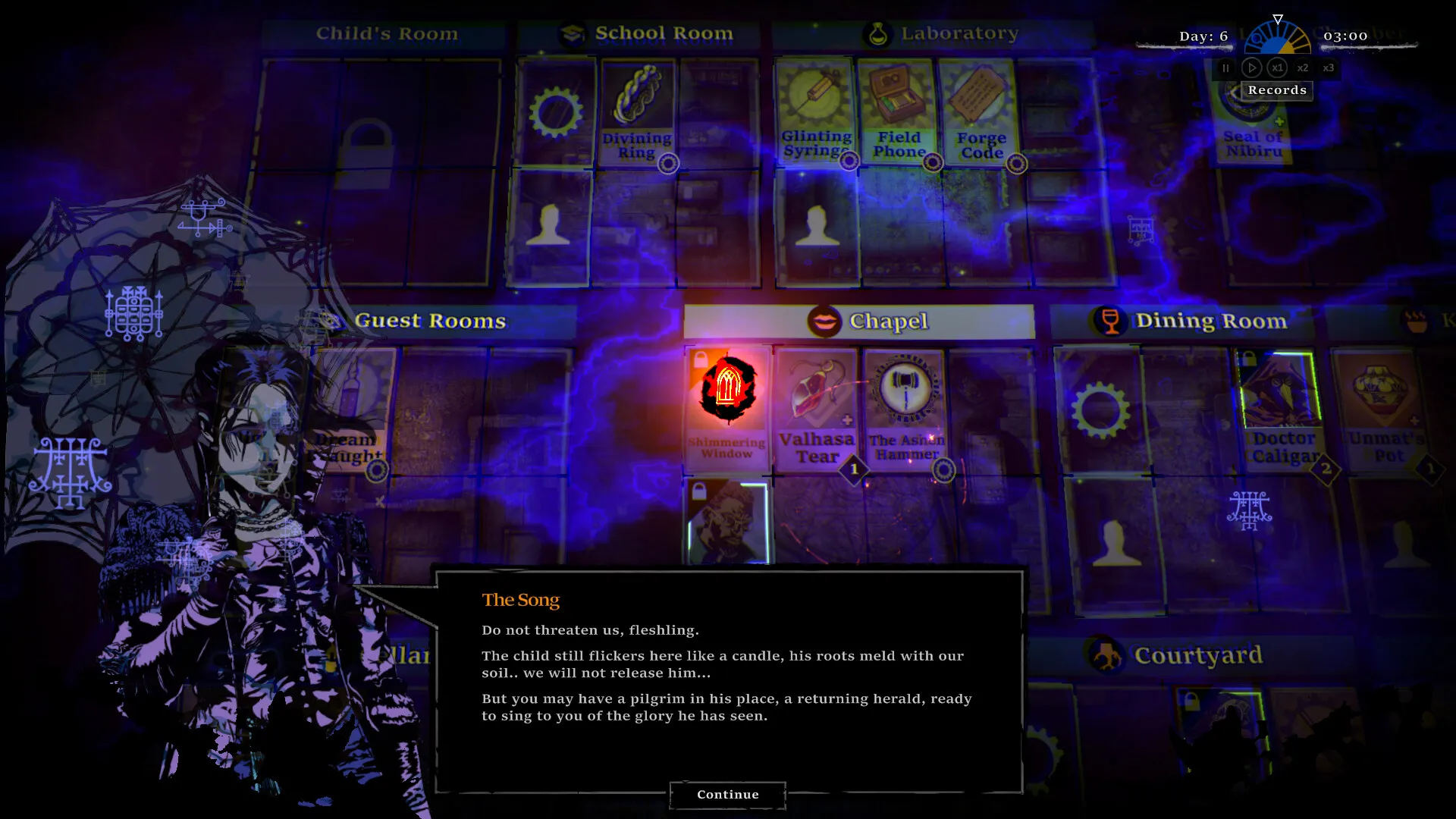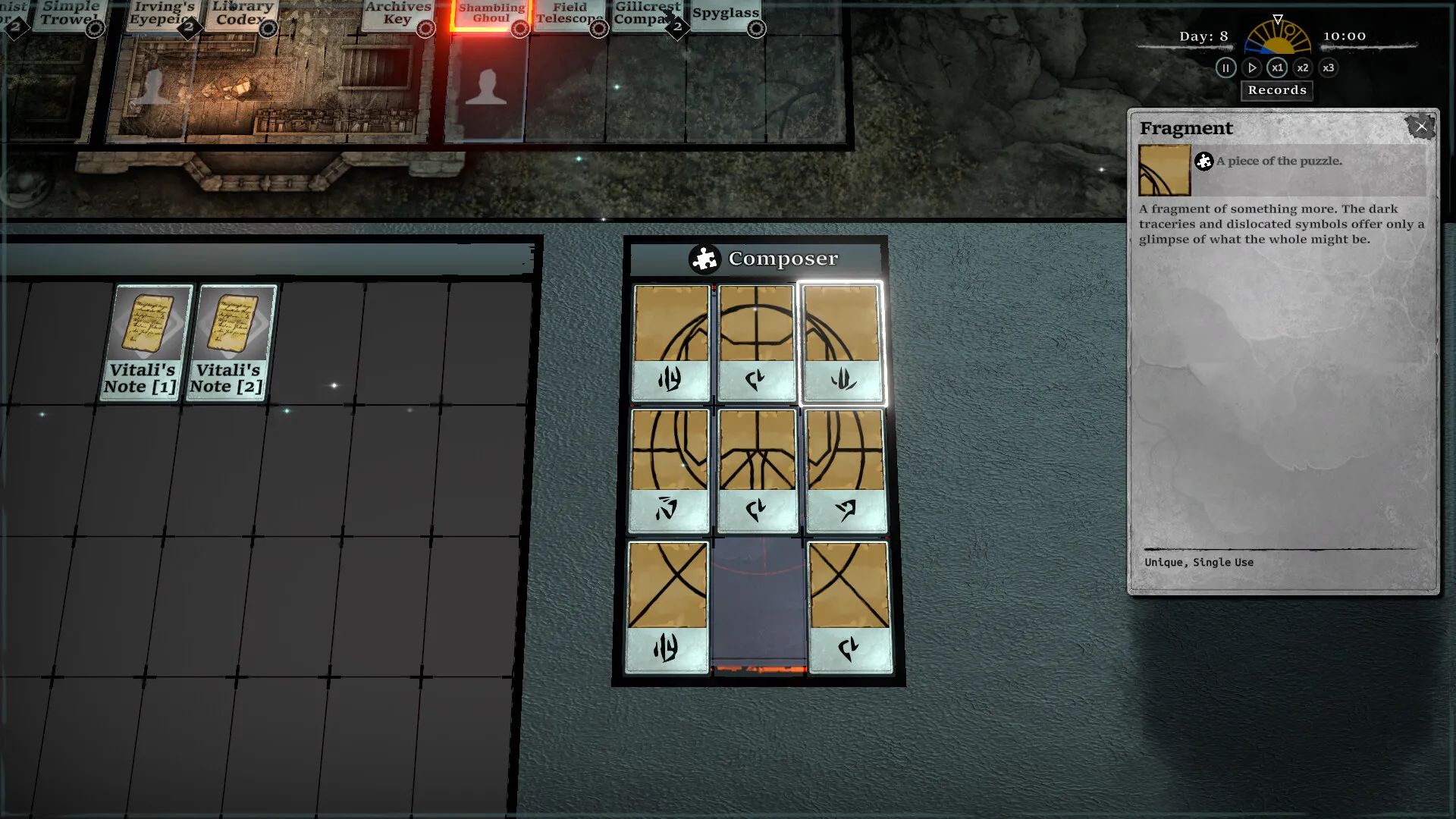Nullpointer Games’ debut transports four investigators to the abandoned Ackeron estate, where whispers of occult rituals and a vanished family set the stage. Players move character cards across a stylized board representing rooms like the Laboratory, Chapel and Courtyard, then assign each investigator’s skills to tasks by dragging task cards into place. Mixing management elements with real‑time and pauseable action, the game asks you to juggle hunger, fatigue and sanity alongside clue hunting and item crafting.
At its core, Highrook asks you to balance strategic planning with narrative momentum. Early chapters guide newcomers through a clear tutorial, while later segments layer in new mechanics—sampling alchemy, ritual assemblies and environmental hazards—that force you to rethink your approach. Choices you make when allocating resources can shift character fates: sending the scholar into the machine room without boosts may save time but risks madness, whereas recruiting Mr Tubbs or Stokes offers sanity relief at the cost of delayed investigations.
The gothic art style, punctuated by stark lighting and period‑inspired illustrations, amplifies the sense of creeping dread. Ambient soundscapes thrum softly until a ritual triggers a sudden swell, reinforcing the game’s emotional stakes. Whether you’re drawn by story or systems, Highrook promises a memorable blend of careful resource juggling and unfolding mystery.
Unraveling Highrook’s Dark Chapters
From the moment the investigators step through Highrook’s wrought‑iron gates, the game establishes its premise: the noble Ackeron family has vanished without trace. Early clues—scrawled journal entries, half‑burned notes in the Study and a lone bloodstain on the foyer floor—drive home an immediate sense of urgency. Those initial discoveries hook you before the mechanics fully click, anchoring each card‑driven action in narrative stakes.
Across eight chapters, new systems punctuate the core loop. Chapter 1 teaches basic tasks—research in the Library, potion mixing in the Laboratory—while Chapter 3 introduces environmental hazards and timed rituals that demand swift choices. By Chapter 5, managing sanity through Mr Tubbs or Stokes becomes crucial, and in later chapters you unlock custom booster cards that reshape how you tackle specific mysteries. Each fresh element arrives just as the base loop begins to feel familiar, nudging you toward new strategies without derailing established resource flows.
Tension ebbs and flows with surprising skill. The opening “prologue” drifts at a patient pace, letting you explore mechanics and absorb setting details. As occult forces gather, the tempo quickens: investigation scenes alternate with tight management sequences, rewarding players who balance downtime planning against creeping fatigue and mounting Madness. That push‑and‑pause rhythm keeps the atmosphere charged without overwhelming newcomers.
Narrative unfolds entirely through text: dusty diaries, corner‑scrawled letters and dialogue cards, all set against stark gothic art. The lack of voice work places full weight on writing clarity—though a text log would ease backtracking when you return after a break.
Side quests for each investigator deepen emotional investment. Uncovering Vitali’s lost thesis or Astor’s secret inheritance feels earned, since choices in dialogue and exploration alter which personal threads come to light—and how they echo the game’s central mystery.
Crafting Fear: Cards, Choice and the Core Loop
The heart of The Horror at Highrook beats through a simple yet engaging cycle: drag a task card into a room, assign an investigator card, then toggle between real‑time action and pause to tweak your plan. This drag‑and‑drop rhythm echoes the tactical tension of Hand of Fate, while its resource juggling nods to Darkest Dungeon’s stress system. Casual players can pause at will to weigh every outcome, whereas veterans find flow in seamless transitions between strategy and execution.
Cards fall into three categories. Investigator cards carry stats for research, machinery, survival and sanity checks. Task cards define actions—crafting potions, repairing engines or decoding clues. Implement and booster cards—moonshine vials, ritual tools, even Mr Tubbs and Stokes—grant extra dice on stat rolls or restore sanity. Layering a raven‑granted boost atop a scholar’s investigation test deepens both mechanical nuance and narrative texture.
Rooms act as mechanical nodes: the Laboratory demands alchemical savvy, the Machine Room tests technical skill, the Courtyard offers foraging opportunities, and the Chapel hosts occult rites. Matching an investigator’s strongest attribute with the right boosters shapes success chances. Send the Mechanist into a ritual without proper implements and you risk fatigue spikes or fractured narrative threads, reinforcing how choices ripple through both play and plot.
Balancing hunger, exhaustion and Madness meters binds mechanics to mood. Watching sanity drain under candlelight channels Darkest Dungeon’s tension, yet pausing to pet Mr Tubbs flips the emotional switch from dread to comfort. These gauges remind you that every eldritch step exacts a cost.
As you progress, fresh mechanics arrive—a ritual‑timing mini‑game here, expanded booster decks there—breathing new life into the core loop. While the mid‑game can settle into a steady groove, learning to wield each tool delivers a satisfying mastery. The onboarding tutorial guides you through systems with clear menus and precise drag‑and‑drop, ensuring the learning curve never derails immersion. In Highrook, every card placement carries weight, weaving mechanics and narrative into a cohesive experience.
Agents of Highrook
Each investigator feels mechanically distinct while fitting into the central mystery. Scholar Vitali carries the highest research stat, making him ideal for the Library and Study. His moderate sanity links narrative reveals to system checks: pairing Vitali with a “Refining Lens” booster raises his threshold, unlocking deeper journal entries. Mechanist Astor excels in the Machine Room and Laboratory, where her crafting and engineering stats turn broken devices into story‑driven tools. A well‑timed gear booster lets her bypass standard checks, speeding up pivotal plot moments.
Atticus Hawk’s high survival and combat attributes drive exploration in the Courtyard and Chapel. Boosters like the Hunting Knife grant extra rolls on fatigue checks, reinforcing his role as protector. Doctor Caligar, with strong alchemy and medicine stats, thrives in both the Kitchen and Laboratory—his Moonshine vial can stave off rising Madness, linking resource management back to character stakes.
Companions extend these dynamics. Mr Tubbs wanders autonomously and grants passive sanity recovery when near investigators, creating quiet respites during tense sequences. Stokes responds to player direction, offering situational boosts in rooms tied to occult tests, which can shift immediate consequences.
Text carries each persona. Vitali’s entries read like academic footnotes, Astor’s notes resemble schematics, Hawk’s reflections are blunt and grounded, and Caligar’s journal carries somber philosophical weight. Optional conversations reveal personal motivations—Vitali’s lost thesis, Astor’s mentor ties—making each side quest a meaningful step toward solving Highrook’s enigma.
Stage Set in Shadows
While Highrook runs on text and cards, its visual signature carries weight. Each room backdrop, from cobwebbed corridors to shadowy laboratories, appears in hand‑painted gothic style, recalling Inscryption’s eerie board‑game scenes yet feeling weathered and authentic. Character and task cards sport parchment textures, worn edges and brown‑ink script that gamers appreciate for clarity and thematic cohesion.
Subtle animation brings cards to life: a flask bubbles faintly on hover, gears click on the Machine Room card, and a lantern icon flickers as darkness closes in. A muted palette of sepia tones and deep shadows keeps eyes on card details, while splashes of crimson mark occult elements.
The UI keeps menus unobtrusive, icons crisp and tooltips instant, so you spend more time planning than hunting controls. High contrast between icon outlines and backgrounds ensures readability when the board fills, echoing Slay the Spire’s clean design ethos.
Audio mirrors the art’s tension. Ambient drones swell during occult rites then fall to near silence as you slide cards into place, making every creak or distant whisper stand out. Task completions emit soft chimes or muted thumps, grounding decisions in sensory feedback. Notably, strategic silence amplifies startling moments—an unseen presence feels alive when a sudden heartbeat thud cuts across the hush. Together, visuals and sound draw you deeper into Highrook’s gothic world, merging tabletop charm with digital horror.
Echoes in the Manor
First run clocks in at roughly nine hours when you pore over every diary entry and note. A second playthrough, chasing side quests with streamlined reading, can wrap in about four hours. Story beats remain fixed—chapter outcomes and ending summaries don’t branch—yet optional character threads offer reasons to return. Uncovering Vitali’s lost research or Astor’s hidden schematics adds narrative layers once you know where to look.
Mastering Highrook’s core loop feels satisfying in repeat sessions. Assigning investigators, layering boosters and juggling sanity grows familiar, letting you settle into a rhythm that balances tension and respite. Without procedural variation or divergent endings, replay value hinges on personal goals—completing every optional scene or testing alternative strategies against the same mysteries.
Highrook fits players who relish a concentrated gothic investigation over a single weekend. If you crave tight card strategy with a haunting setting and don’t need branching narratives, the game delivers a focused, replayable puzzle of dread and discovery.
Under the Hood
Text quality shows care in world‑building but occasional typos and grammar slips interrupt immersion. A misplaced comma or misspelled word in a critical journal entry can pull you out of tense moments, especially when you’re deep into investigations.
Stability remains rock solid. No crashes or freezes surfaced during testing, and frame rates held steady across exploration and ritual animations. Highrook feels responsive whether you’re on PC or console.
Usability hinges on pause‑mode planning, which balances the pressure of real‑time events. The lack of a text log means tracking dialogue requires extra note‑taking, and the absence of voice work places full weight on written clarity.
Accessibility features include adjustable font sizes and high‑contrast UI themes, with support for key remapping. These options help maintain readability when cards flood the board.
Indie charm shines through despite rough edges. Polishing typos, adding a text history log and refining tooltip timing would elevate the experience without compromising the game’s handcrafted atmosphere.
The Review
The Horror at Highrook
Highrook excels at weaving card‑driven strategy and gothic storytelling, its intuitive drag‑and‑drop loop reinforcing each mystery reveal. Atmospheric art and ambient audio sharpen every choice, while resource and sanity management keep stakes tangible. Text typos and fixed endings feel minor next to its compelling mechanics and mood. Players seeking an immersive indie RPG will find Highrook hard to resist.
PROS
- Engaging core loop that balances strategy and narrative
- Distinct investigator roles with meaningful stat synergies
- Gothic art and ambient audio that deepen immersion
- Intuitive drag‑and‑drop interface with pause‑mode planning
- Companion mechanics that tie resource management to story tension
CONS
- Occasional typos and grammar slips in key text
- Fixed chapter outcomes limit narrative variation
- Absence of a text log hampers backtracking
- Mid‑game familiarity can edge toward repetition





















































